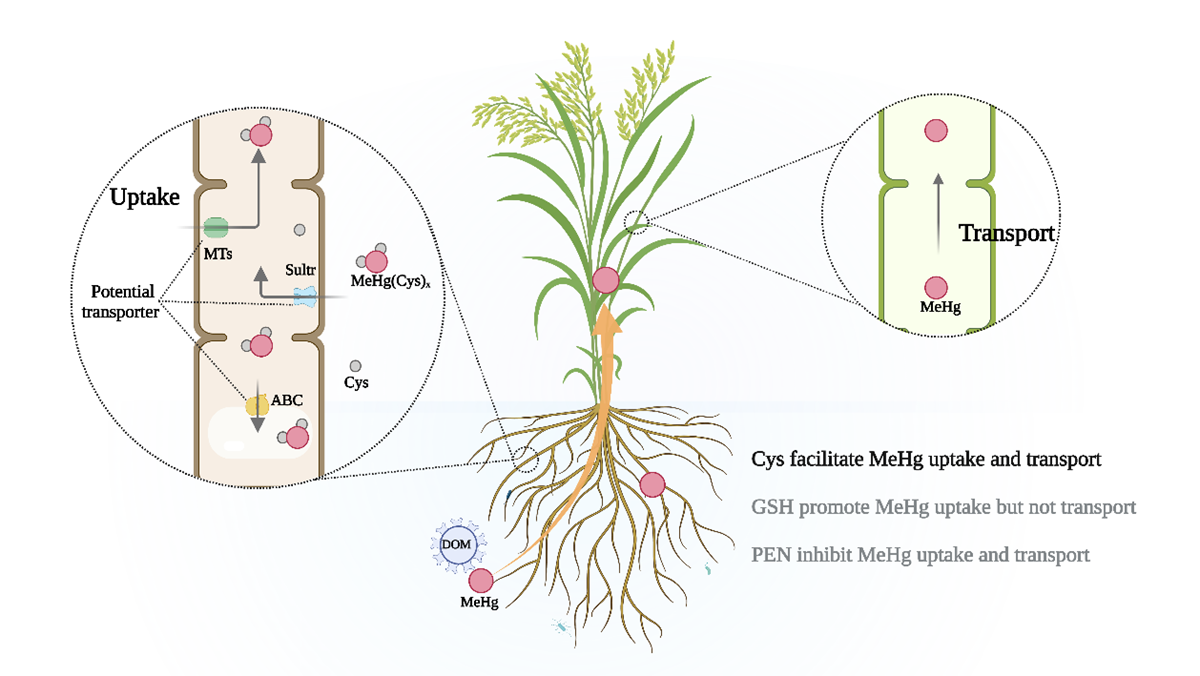南湖新闻网讯(通讯员 郝芸芸)近日,我校资源与环境学院刘玉荣教授课题组在水稻吸收甲基汞领域取得新的进展,相关成果以“Important roles of thiols in methylmercury uptake and translocation by rice plants”为题发表在Environmental Science & Technology上。

图一 巯基对水稻吸收和转运甲基汞影响示意图
甲基汞(MeHg)具有强神经毒性,可通过食物链在生物体内累积和放大,从而威胁人类健康,食用大米是人类摄入MeHg的一个主要途径。MeHg的生物有效性受环境因子,如低分子量巯基化合物(半胱氨酸Cys等)等溶解性有机质影响。此外,稻米中的MeHg主要是以与Cys的结合态存在,从而可推测巯基化合物在水稻甲基汞积累过程中发挥着重要作用。然而,Cys等巯基化合物对水稻吸收和转运MeHg的影响及相关分子机制此前尚不清楚。
通过研究典型的低分子量巯基化合物对水稻MeHg吸收和转运的影响,课题组发现水稻根系能迅速吸收MeHg,这一过程受体系中巯基化合物类型和浓度的影响。Cys的存在促进了根对MeHg的吸收和向地上部的转运;谷胱甘肽只能促进MeHg的吸收而不能促进转运;相反,PEN显著抑制了MeHg的吸收和转运。通过分析用13C标记的Cys,研究发现水稻对MeHg的吸收与Cys在根系中的积累有关。通过转录组学比较分析,课题组发现了74个基因发生显著变化,其中3个基因在Cys的作用下进一步上调,由此推断金属硫蛋白和硫转运蛋白相关基因可能参与水稻对MeHg的吸收。这些发现增加了对水稻吸收MeHg的认知,为稻田汞污染调控提供了重要的理论依据。
资源与环境学院博士研究生郝芸芸为论文第一作者,刘玉荣教授为通讯作者,美国橡树岭国家实验室顾宝华教授、华中农业大学王创教授,冯娇副研究员、黄巧云教授、本科生朱玉杰、严若群等也参与了该项研究。该研究得到了国家自然科学基金和华中农业大学人才引进项目资助。
审核人:刘玉荣
【英文摘要】
The bioaccumulation of the neurotoxin methylmercury (MeHg) in rice is a significant concern due to its potential risk to humans. Thiols have been known to affect MeHg bioavailability in microorganisms, but how thiols influence MeHg accumulation in rice plants remains unknown. Here, we investigated effects of common low-molecular-weight thiols, including cysteine (Cys), glutathione (GSH), and penicillamine (PEN), on MeHg uptake and translocation by rice plants. Results show that rice roots can rapidly take up MeHg, and this process is influenced by the types and concentrations of thiols in the system. The presence of Cys facilitated MeHg uptake by roots and translocation to shoots, while GSH could only promote MeHg uptake, but not translocation, by roots. Conversely, PEN significantly inhibited MeHg uptake and translocation to shoots. Using labeled 13Cys assays, we also found that MeHg uptake was coupled with Cys accumulation in rice roots. Moreover, analyses of comparative transcriptomics revealed that key genes associated with metallothionein and SULTR transporter families may be involved in MeHg uptake. These findings provide new insights into the uptake and translocation of MeHg in rice plants and suggest potential roles of thiol attributes in affecting MeHg bioavailability and bioaccumulation in rice.

